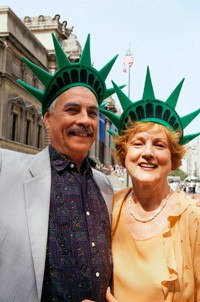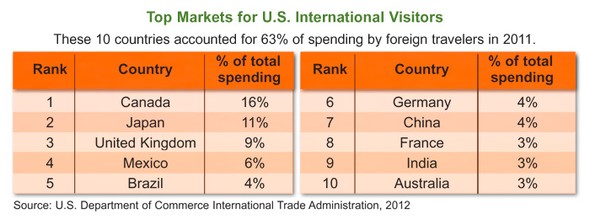Coming to America: Foreign Travelers Boost U.S. Economy
 International visitors to the United States spent a record $153 billion in 2011, an increase of 14% over 2010. That’s good news, but just as significant is the fact that the travel and tourism balance of trade produced a surplus of $42.8 billion — a historic high and a 35% increase over the previous year.¹
International visitors to the United States spent a record $153 billion in 2011, an increase of 14% over 2010. That’s good news, but just as significant is the fact that the travel and tourism balance of trade produced a surplus of $42.8 billion — a historic high and a 35% increase over the previous year.¹
At a time when the overall trade deficit and slow economic growth continue to cause concern, the international travel boom provides a bright spot that helps stimulate local economies. Three-fourths of the spending goes to local goods and services, including food, lodging, recreation, gifts, entertainment, incidentals, and transportation in the United States.2 The tourism and travel industry (including domestic travel) supports 14.4 million jobs, either directly or indirectly — about one out of nine U.S. jobs.3
Bouncing Back from 9/11 and Global Recession
It’s not surprising that income from foreign visitors dropped after the terrorist attacks of September 11, 2001. International travel to the United States began to increase in 2004, only to drop again in 2009, the low point of the global recession.4 Last year surpassed pre-recession levels, and 2012 is off to a great start. Spending for the first four months increased by more than 13% over the same period in 2011.5
The flow of funds from foreign visitors is classified as an export in federal accounting and plays a meaningful role in the larger framework of U.S. trade. In 2011, spending by foreign travelers accounted for 7.3% of all U.S. exports, an amount that exceeded two major export categories: automotive vehicles, parts, and engines; and food, feeds, and beverages.6 The growth rate of travel and tourism exports from April 2011 to April 2012 was twice that of overall U.S. exports.7
Selling “Brand USA”
The weakening of the dollar against foreign currencies makes U.S. travel less expensive for foreign visitors. But the dollar has been weak for several years, so other factors may be contributing to the recent upsurge.8 One could simply be an improving world economy. Global GDP has increased since 2009 — despite the fiscal crisis in the eurozone — and emerging nations such as China, Brazil, and India are developing a more affluent class of citizens who can afford to travel overseas.9-10
To capture a larger share of the international travel market, Congress established a marketing agency in 2010 called Brand USA, which recently launched a multimillion-dollar marketing campaign funded by a combination of private and public funds.11 The federal government is also considering changes to visa regulations to make it easier for visitors from certain countries to travel to the United States.12

Although travel and tourism may not get headlines in economic news, the industry contributes almost 3% to U.S. gross domestic product.13 Foreign travelers spend an average of $4,000 per trip, and it’s estimated that 35 international visitors support one U.S. job.14 Promoting Brand USA won’t solve larger economic issues, but the continuing growth of the U.S. travel and tourism industry could potentially be a significant factor in the nation’s economic recovery.
1–2, 5–6, 10, 13) U.S. Department of Commerce International Trade Administration, 2012
3, 7, 12) U.S. Travel Association, 2012
4) U.S. Bureau of Economic Analysis, 2012
8) The Wall Street Journal, May 18, 2011
9) International Monetary Fund, 2012
11, 14) Brand USA, 2012
The information in this article is not intended as tax or legal advice, and it may not be relied on for the purpose of avoiding any federal tax penalties. You are encouraged to seek tax or legal advice from an independent professional advisor. The content is derived from sources believed to be accurate. Neither the information presented nor any opinion expressed constitutes a solicitation for the purchase or sale of any security. This material was written and prepared by Emerald. Copyright © 2012 Emerald Connect, Inc.

